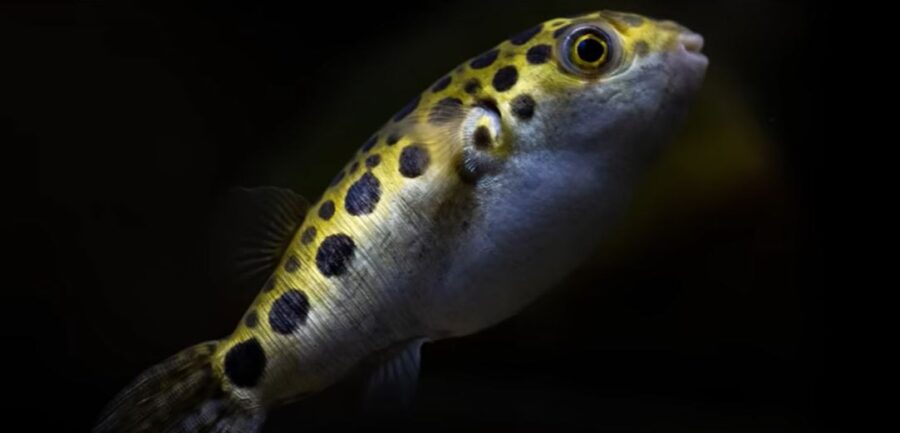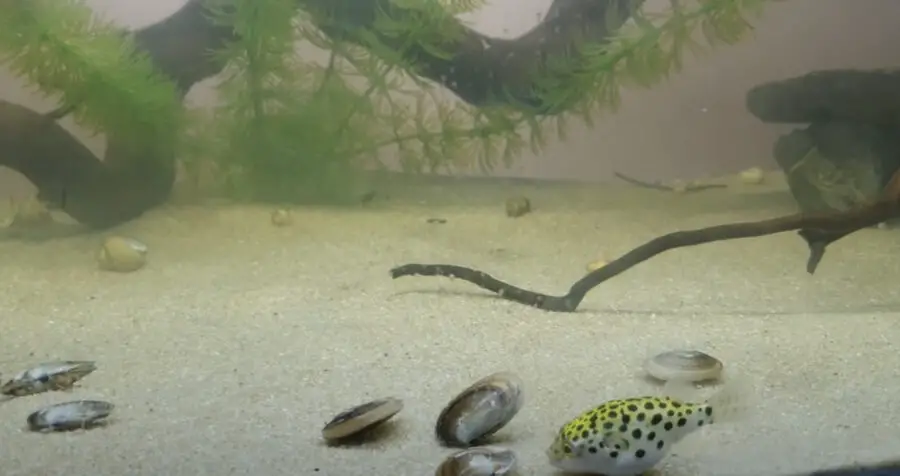The green spotted puffer (GSP) is a fish with unique needs and requires care.
How do you treat a sick green spotted puffer fish when they refuse to eat?
In this article, you will understand more about green spotted puffer fish and how they can be treated when sick.
How Do You Treat a Sick Green Spotted Puffer Fish?
The GSP fish can get sick due to several problems, so possible treatments vary tremendously.
Parasitic infections, such as Ichthyophonus, and Nanophyetus salmincola, require treatment with specialized medicines, such as malachite green and other Ich formulas.
- Immaculate water conditions are essential for treating sick green spotted puffers.
- Nitrite levels should not to rise more than 20ppm.
- Eliminate any detectable ammonia in the water.
- Raise the salinity and alkalinity of the aquarium, either temporarily or permanently, to prevent and eliminate illness.
Sick green spotted puffers should never be kept in a freshwater habitat because they are obligate brackish-white water fish.

Signs Of A Sick Green Spotted Puffer Fish
Fishes have their way of life, which makes us feel they are okay. But when they exhibit certain abnormal behaviors, they may then be sick.
Some of the signs of sickness in sick puffers is when:
- They gasp at the surface. Gasping at the surface is a sign brought on by poor water conditions, usually due to a lack of oxygen.
- Sick green spotted puffers may lie on the bottom of the tank and appear lifeless. A puffer should never act sulky or lazy. These feisty critters thrive on constant movement and activity.
- Green spotted puffers sometimes curl their tails against their bodies as a defensive measure when they are asleep or not feeling well. A deep “U” curve may indicate the puffer is afraid or ill.
Signs of a Healthy GSP
A healthy green spotted puffer should:
- make eye contact
- eagerly accept food
- swim briskly around the tank
- no signs of being frightened, injured, or overcrowded
- neon-hued yellowish-green body with deep black spots and a white underbelly.
When they are sick, they tend to lose such characteristics. If you see consistently dark brownish-grey discoloration or a grey belly, there’s a good chance that your green spotted puffer is sick.
Why Is My Green Spotted Puffer Fish Ill?
The answer usually rests on:
- poor water quality
- tank sizes being too small
It is not surprising to see Green Spotted Puffer Fish ill after being infected. They get:
- weak
- lose appetite
- hide excessively
- act lethargic
- lose color
Quick treatment helps avoid worsened illness. You will find your Green Spotted Puffer Fish back on track when you look out for the signs above and take every measure to keep the tank healthy.

Why Is My Puffer Fish Laying on the Bottom Of the Aquarium?
The puffer fish lies at the bottom of the tank because it has nothing to do. A fish caged in a glass might sometimes not have anything to do in some periods, unlike the fish in the river or sea.
- The primary reason why fish lay on the bottom of aquariums is because they are sick. When they are ill, they tend to be inactive and dull.
- Another reason they lie on the bottom of the aquarium is when the water in the aquarium is of low quality. And maybe because of the amount of feed you give to your fish.
Why Is Green Spotted Puffer Fish Turning Black?
Like chameleons, green spotted puffers change their colors to indicate their:
- mood
- health
They tend to turn off their spots and dull themselves when they feel sick or asleep. Whenever fin rot and black spotting can be found on the body of the green spotted puffer fish, it often indicates:
- toxic water conditions
- ammonia and nitrite poisoning
If your puffer always has a grey or black belly, it may be a sign that something is wrong in the fish tank, and you might need to review the tank management practices.

Why Is Green Spotted Puffer Fish Not Eating?
When your puffer is not eating, it may be due to unclean water. When the water in the fish tank is dirty, the puffer might not eat as you want it to. If you try to change the water in the tank, it might aid the rate at which the puffer eats.
A puffer fish requires a rich source of:
- protein
- micronutrients
- essential fatty acids
Whenever these are not present in the food you give to them, they will not have the appetite to eat any other kind of food you provide.
Also, if the green spotted puffer fish (GPS) has excessive internal parasites or worms, it might not show much interest in the food you give to the puffer fish.

Conclusion
We hope this article helps you to take better treatment of your puffer fish. Having unhealthy fish in the tank puts others at risk of falling sick.
You can have an expert check your tank, but you will find these tips helpful in understanding your GSP better.
Thank you for stopping by at HelpUsFish.com. We have plenty of articles on a wide variety of aquatic and marine life that may also pique your interest. See you again soon!
Table of Contents
